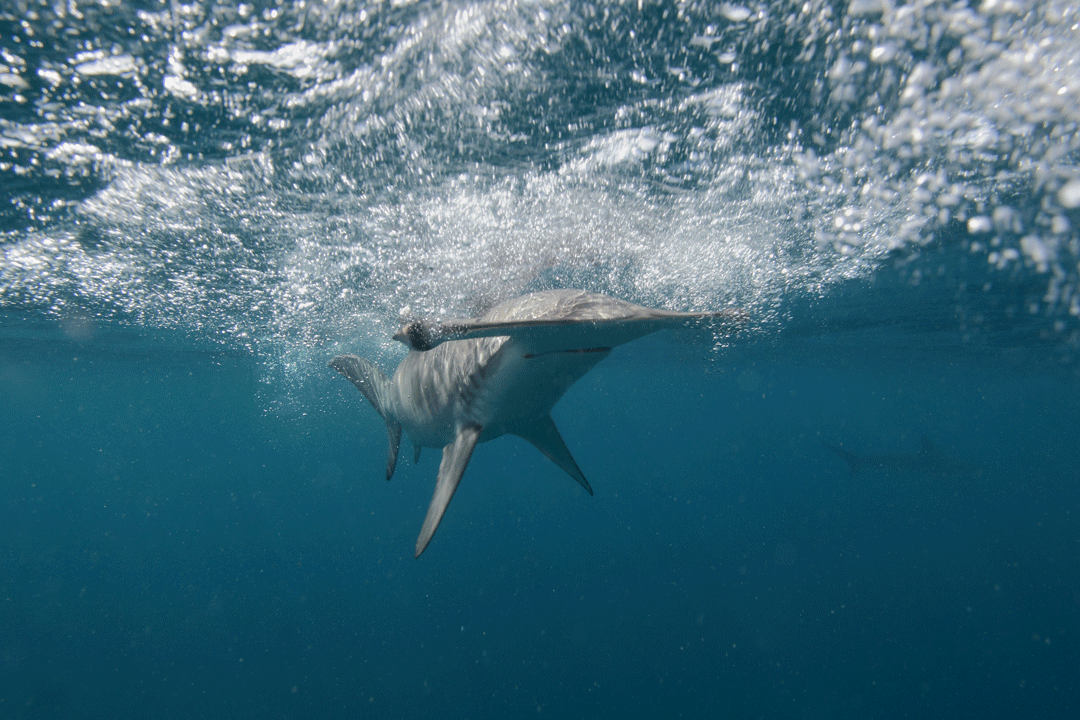Hovering hammerheads
Hammerhead sharks are undoubtedly amongst the most recognisable species of shark on the planet. This group consists of nine species which are widespread in temperate and tropical seas, and includes the great hammerhead (EN)*, scalloped hammerhead (EN), smooth hammerhead (VU), smalleye hammerhead (VU), Carolina hammerhead (no assessment), bonnethead (LC), scalloped bonnethead (NT), winghead (EN) and scoophead (DD) sharks. Many of these species are under threat due to a variety of anthropogenic impacts including overfishing and a demand for their fins, which are considered a delicacy.

Endangered scalloped hammerhead shark. Photo © Janos Rautonen | Shutterstock
Legislation has been put in place that aims to protect hammerhead species in South Africa. In 2011, retention of all hammerhead species was banned in the pelagic longline fishery, and in 2015 catches were further prohibited in all commercial fisheries except for the linefishery (da Silva et al. 2015, Dicken et al. 2018). The bycatch of juvenile hammerhead sharks in the coastal dermersal longline fishery has also been recorded. The KZN bather protection programme is an additional source of fishing mortality, where it is the 14th most commonly caught shark species (Dicken et al. 2018).
Two species of hammerhead sharks occur off the coast of South Africa, namely the scalloped hammerhead (Sphyrna lewini) and smooth hammerhead (Sphyrna zygaena). The smooth hammerhead is commonly found in temperate and tropical seas and has a more widespread southern African distribution compared to the scalloped hammerhead, extending from St Helena Bay in the Western Cape to southern Mozambique. This species can reach a length of 4 m and a weight of over 160 kg. A maximum age is yet to be determined, although it is thought to reach 20 years or older.

A smooth hammerhead shark, photographed at Cape Infanta, South Africa. Photo © Alessandro De Maddalena | Shutterstock
Smooth hammerheads are one of the least studied pelagic sharks and little is known about its movement patterns, habitat use and population dynamics for any part of its southern African distributional range. According to the Oceanographic Research Institute’s Cooperative Fish Tagging Project (ORI-CFTP), 1625 smooth hammerheads have been tagged with conventional dart tags since 1984 and only 21 have been recaptured (1.29% recapture rate). The average distance moved by these individuals was 139 km, and a maximum distance moved of 384 km has been recorded. This species is thought to be migratory, with juveniles occurring closer inshore, migrating offshore with an increase in size. However, more information on their movement behaviour is needed.
ATAP researchers opportunistically tagged three juvenile smooth hammerhead sharks, which have shed some new light on their movements along the South African coastline. Of the three individuals tagged, two were subsequently detected on the ATAP array. One individual, tagged near Vleesbaai in the Western Cape on 22 February 2016, was subsequently recorded in Mossel Bay (between 17 and 20 March 2016) before moving eastwards to Plettenberg Bay where it was detected for one day (06 May 2016) before disappearing from the array. Similarly, the other individual, tagged in the same area on 26 February 2016, was recorded six days later on a receiver near the De Hoop Marine Protected Area, approximately 100 km to the west of the release site (travel speed of almost 17 km/day). It then moved eastwards to Mossel Bay, spending two days (17 and 18 April 2016) there before moving another 130 km eastwards to Plettenberg Bay, where it was recorded sporadically for 21 days between 22 April and 12 May 2016. It disappeared from the array for three months, before being detected again in Algoa Bay (approximately 300 km eastwards) on 28 August 2016. Within Algoa Bay, it moved between the Islands of the Cross (Jahleel, St Croix and Brenton) and Bird Island for approximately three and a half months. This individual was last detected on 15 December 2016 on the Brenton Island receiver in Algoa Bay. The maximum distance this animal moved was at least 530 km. These preliminary results clearly suggest that juvenile smooth hammerhead sharks are highly mobile, making regular long distance movements.

Smooth hammerhead shark. Photo © Alessandro De Maddalena | Shutterstock
Hammerhead sharks are commonly caught as bycatch by recreational shore anglers, forming an important component of the competitive shore fishery in KwaZulu-Natal and the former Transkei. Although all captured sharks are released in this fishery, they are vulnerable to capture stress and susceptible to post-release mortality (Coelho et al. 2012, Gallagher et al. 2014). The fact that one of the tagged sharks was never recorded suggests that it could have succumbed to capture (and tagging) stress after being released. However, it is evident that two of the sharks survived the capture and tagging event and were subsequently detected by the ATAP array. These hammerheads were tagged with long-life transmitters with a battery life of 10 years, but were recorded for less than one year. It is possible that these two sharks succumbed to some other form of fishing mortality, such as from the demersal longline shark fishery that operates along the southern Cape coastline. Acoustic telemetry not only provides important information on the movement behaviour of animals, but can also provide insights into their vulnerability to fisheries.
